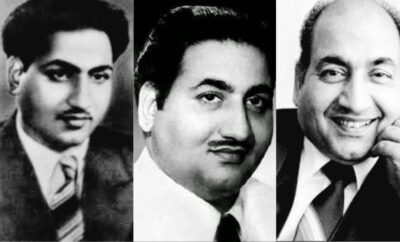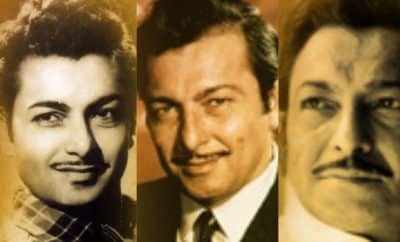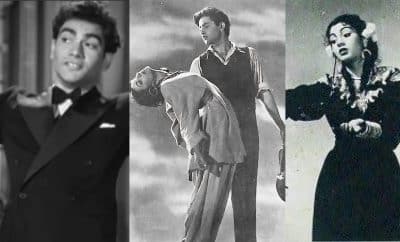Collections
Chitragupt and Lata Mangeshkar – Magicians of Melodies (Part 1)
There is a Subhaashitam (a verse with a good message) in Sanskrit –
दधि मधुरं मधु मधुरं द्राक्षा मधुरा सुधापि मधुरैव ।
तस्य तदेव हि मधुरं यस्य मनो यत्र संलग्नम् ॥
It means – curd is sweet, honey is sweet, grapes are sweet and so is nectar. However, wherever one’s mind is attached, he or she finds that thing sweet. Fair is not fair, but that which pleaseth, as they say!
Don’t worry, I am not starting a Sanskrit or philosophy class! ? This verse always crosses my mind when I think of Lata Mangeshkar’s songs. Just as among all the sweet things, some things are sweeter than many others; among all the sweet songs that she has sung, particularly at the zenith of her career, a few songs sound sweeter than most others. When I wonder why she would have consistently added a few extra drops of nectar to her rendition for a few composers, the second line of the verse answers my question – the compositions had inherent sweetness, and hence her mind was attached to those compositions (and so is ours)! C. Ramchandra, Madan Mohan, Usha Khanna and R.D. Burman are some of the composers, under whose baton Lata Mangeshkar sounded sweeter.
Another name that deserves mention in this league is Chitragupt, though not as famous as the other names. Though Chitragupt may not be considered as a leading composer of the golden era by many, when we listen to his songs, particularly the ones rendered by Lata Mangeshkar, we absolutely accept him as the master of sweet tunes, which Lata Mangeshkar has made sound even sweeter!
Born as Chitragupt Shrivastav on 16 November 1917 in Bihar, he was an M.A in economics. He left his job as a lecturer in a college in Patna and came to Mumbai in the 1940s to make a career as a composer. Initially, he worked as an assistant to S.N. Tripathi and then started composing music as an independent composer.
It was only after struggling for a few years that S.D. Burman introduced him to a banner of standing, AVM, in the 1950s, for which he went on to compose many soundtracks. He worked on some mainstream commercial films during the 1950s and the 1960s. In his career spanning across 5 decades, he composed music for about 150 films. However, as many of these were B-grade films, Chitragupt could never make it to the first row of composers, despite his dazzling tunes and captivating orchestration.
In spite of being a post-graduate in economics, it seems he could not manage to understand the “economics” of the brutal world of cinema. However, his music was original, which pleases the music aficionados more as they listen to it more – quite contrary to the famous law of “diminishing marginal utility” in economics! His music for films like Bhabhi (1957), Kali Topi Lal Rumal (1959), Barkha (1960), Opera House (1961), Main Chup Rahungi (1962), Ganga ki Lahren (1964), Oonche Log (1965) and Akashdeep (1965) is still fondly remembered and speaks volumes about his calibre.
He remained undisputed monarch in Bhojpuri films though; and before breathing his last in 1991, he at least had the satisfaction of seeing his sons Anand – Milind achieve success at the box office.
His association with Lata Mangeshkar seems to have started with Shiv Bhakta (1955). Out of the total 240 songs that Lata Mangeshkar has rendered under Chitragupt’s baton, a majority of the songs are romantic and all of them are extremely pleasing to ears. Let us relish some of the magical masterpieces created by Chitragupt and Lata Mangeshkar together, which are no less in terms of saccharinity than the Lata – Madan Mohan or Lata – C. Ramchandra songs.
1. Kaare Kaare Baadra (Bhabhi – 1957)
This is a honey-sweet and frolicky composition based on raag Vrindavani Sarang from the AVM family drama Bhabhi, filmed on pretty and pretty-expressive Shayma and penned by Rajinder Krishan.
2. Dagha Dagha Wai Wai Wai (Kaali Topi Laal Rumaal – 1959)
This is a playful song composed for street-dance from Kaali Topi Laal Rumaal – a tale of two friends. The song is composed by Chitragupt in middle eastern style and penned by Majrooh Sultanpuri with intriguing words like “Dagha Dagha Wai Wai Wai” (an expression of the realisation of being cheated) and “Che-kunam” (an expression of bafflement). Kumkum’s frisky dance makes the composition more beautiful.
https://www.youtube.com/watch?v=Fre-2aq796Y
The soundtrack has another beautiful Lata solo – “Na to dard gaya, na dawa hi mili”.
3. Dil Ko Laakh Sambhaala Ji (Guest House – 1959)
This is yet another saccharine Lata solo from the mystery film Guest House picturised on lovely Shakeela who is expressing her love to Ajit, who is seen acting to play piano by scratching the piano keys. (Though it is hard to accept Ajit as a romantic hero, surprisingly he has a handful of romantic songs to his credit.) The song is penned by Prem Dhawan and is pleasingly decorated by Chitragupt mainly with piano and flute.
4. Rang Dil Ki Dhadkan Bhi Laati To Hogi (Patang – 1960)
Patang is a drama film featuring Mala Sinha and Rajendra Kumar in the pivotal roles. Visually impaired Mala Sinha is missing her loved one and expressing her feelings through this song. Rajinder Krishan has penned her innocent feelings effectively and Lata Mangeshkar has rendered the mellifluous tune in a sugar-dipped voice.
5. Balma Maane Na (Opera House – 1961)
This semi-classical dance-number based on raag Malkauns from yet another mystery film Opera House is penned by Majrooh Sultanpuri in chaste Hindi. B. Saroja Devi’s dance is another highlight of this song. This film too has a romantic song in which Ajit features (Dekho mausam, kya bahaar hai!).
6. Tumhi Ho Maata, Pita Tumhi Ho (Main Chup Rahungi – 1962)
Main Chup Rahungi was also an AVM drama film with Meena Kumari and Sunil Dutt in the lead roles. The song is filmed on Babloo, who plays an orphan in the film. Unaware of his parents, he believes God to be his whole and sole. His innocence and faith expressed through the song pulls on our heartstrings. Rajinder Krishan’s words very effectively bring out his innocent feelings.
7. Deewane Tum, Deewane Hum (Bezubaan – 1962)
This is a romantic gem from an obscure film Bezubaan picturised on Helen and Aroop Kumar. Chitragupt’s composition is adorned with pleasant Indian and western orchestration instruments and Lata Mangeshkar’s dulcet rendition. The lyrics are penned by Prem Dhawan.
8. Uthegi Tumhari Nazar Dheere Dheere (Ek Raaz – 1963)
Ek Raaz, directed by Shakti Samanta, was a package of nicely plotted mystery, romance, comedy and lost-and-found tale. The lead roles were played by Kishore Kumar and Jamuna. The Kishore Kumar – Lata dominated soundtrack of the film is certainly among the best works of Chitragupt.
This is a dance number in which the dancer (Madhumati) is seen wooing Pran. Again, the orchestration has a nice blend of Indian and western instruments and Lata Mangehskar’s sweet rendition with a slight sensual touch sounds euphonious. Majrooh Sultanpuri is the lyricist.
9. Haye Re Tere Chanchal Nainwa (Oonche Log – 1965)
Oonche Log was a multi-starrer film with Ashok Kumar, Raj Kumar and Feroz Khan in the main roles. It was Feroz Khan’s first hit. The song expresses a loving complaint in Majrooh Sultanpuri’s simple words rendered softly by Lata Mangeshkar. Chitragupt’s soft tune and orchestration transports you to a different world. The song has two versions – the one that has gone on many records and cassettes as a Lata solo and the other, a duet, wherein Feroz Khan intermittently croons the refrain alongwith the radio in Mahendra Kapoor’s voice. This is certainly one of the best joint works of Lata Mangeshkar and Chitragupt.
https://www.youtube.com/watch?v=JJutDJaMtLE
10. Dil Ka Diya Jala Ke Gaya (Akash Deep – 1965)
This is an exotic dessert stupendously made by the two expert chefs – Chitragupt and Lata Mangeshkar, based on the beautiful raag Jayjaiwanti. The song, playing on a record in the background, is a sombre expression of a mute girl played by Nimmi (named as Baani – look at the paradox!) who has just fallen in love. Chitragupt has thoughtfully kept the tune somewhat subdued, so that it suits the context. Violins in the prelude convey the thrill that she is experiencing and soon jaltarang starts tinkling, matching her soft feelings. The optimal interludes – neither too soft not too flashy – also compliment the mood of the song. Lyrics by Majrooh Sultanpuri written in his unique style garnish this dessert with another pinch of sugar. Keeping in mind that Baani is not proclaiming her love, but is rather softly expressing it to herself, Lata Mangeshkar sweetly croons the song letting out the secret of her feelings, thereby creating a velvety whispering wonder!
Aren’t the magical masterpiece created by the duo addictive? More you listen to them, more you yearn. Coming soon with a sequel with more such delicacies to quench your longing!




Anandvardhan
November 16, 2021 at 12:04 pm
Chitragupta created divine music we will cherish eternally
Madhupati Sharma
November 16, 2021 at 8:47 pm
It should be in reverse order..
The choices are the best possible. One- Mere dil kabhi to koi aayega is also worth consideration.
Sweetness sometimes differs in choice.
Kanu D
November 16, 2021 at 11:17 pm
Excellent writeup as always
YOGESH
October 23, 2022 at 11:55 pm
Thanks a lot!
Rahul Bhagwanrao Muli
November 22, 2021 at 2:01 pm
Excellent post about one of the most underrated composers. He was able to extract that extra sweetness from Lataji’ s voice even in late 60s.
Kab tak hujoor from Aulad and main sadake jaaun from Vaasana should have been there in the list.
YOGESH
October 23, 2022 at 11:58 pm
Thanks Rahul ji! Choice is really difficult, feeling like a kid in a candy store 🙂 Nonetheless, part 2 is coming soon…
Pingback: Carnival of Blogs on Golden Era of Hindi Film Music – Volume X – November 2022 Edition – The world is too small? or Is it?